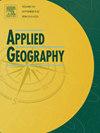韧性在可持续发展目标中重新显现:从中国放宽COVID-19限制的角度看
IF 4
2区 地球科学
Q1 GEOGRAPHY
引用次数: 0
摘要
在大流行后时代,可持续发展目标已演变为具有复原力和适应性的系统,可动态应对大流行的影响及其相关限制。本研究使用基于13个与流行病相关的目标和47个指标的框架评估了中国的可持续发展目标绩效。数据从220个城市和30个省份的1027名参与者中收集,分为三个阶段,由关键政策变化定义。结果显示,SDG 3和SDG 16在感染初期受到的影响最大,在感染波消退后SDG 16恢复明显。32个指标在最初下降后有所改善,81.82%的权衡指标对在第一波感染期间——主要是经济发展可持续发展目标(即可持续发展目标1、8、11)和政府政策可持续发展目标(即可持续发展目标3、4、16)之间——转变为协同效应。这表明,在最初的大流行影响之后,可持续发展目标的复原力再次出现。经济发展水平较低的地区在可持续发展目标绩效方面表现出更大的脆弱性。女性、低收入人群和中小城市居民的可持续发展目标绩效往往较低。该研究还强调了公众关注的焦点从直接生理需求转向自我发展需求。这一转变强调了在政策突然变化的情况下,适应性战略在实现可持续发展目标方面的重要性。本文章由计算机程序翻译,如有差异,请以英文原文为准。

Resilience reemerged in sustainable development goals: A perspective on easing COVID-19 restrictions in China
In the post-pandemic era, sustainable development goals (SDGs) have evolved into resilient and adaptive systems, responding dynamically to the impacts of the pandemic and its associated restrictions. This study assessed SDG performance in China using a framework based on 13 pandemic-related goals and 47 indicators. Data were collected from 1027 participants across 220 cities and 30 provinces during three stages, defined by key policy changes. Results show that SDG 3 and 16 were most impacted at the outset and SDG 16 recovered significantly after the infection wave subsided. 32 indicators improved after initial declines, and 81.82% of trade-off indicator pairs during the first infection wave—primarily between economic development SDGs (i.e. SDG 1, 8, 11) and government policy SDGs (i.e. SDG 3, 4, 16)—transitioned to synergies. This suggests a reemergence of SDG resilience after the initial pandemic impact. Regions with lower economic development exhibit greater vulnerability in SDG performance. Women, low-income individuals, and residents of medium-to small-sized cities tend to show lower SDG performance. The study also highlights a shift in public focus from immediate physiological needs to self-development needs. This shift underscores the importance of adaptive strategies in achieving SDGs in the face of abrupt policy changes.
求助全文
通过发布文献求助,成功后即可免费获取论文全文。
去求助
来源期刊

Applied Geography
GEOGRAPHY-
CiteScore
8.00
自引率
2.00%
发文量
134
期刊介绍:
Applied Geography is a journal devoted to the publication of research which utilizes geographic approaches (human, physical, nature-society and GIScience) to resolve human problems that have a spatial dimension. These problems may be related to the assessment, management and allocation of the world physical and/or human resources. The underlying rationale of the journal is that only through a clear understanding of the relevant societal, physical, and coupled natural-humans systems can we resolve such problems. Papers are invited on any theme involving the application of geographical theory and methodology in the resolution of human problems.
 求助内容:
求助内容: 应助结果提醒方式:
应助结果提醒方式:


